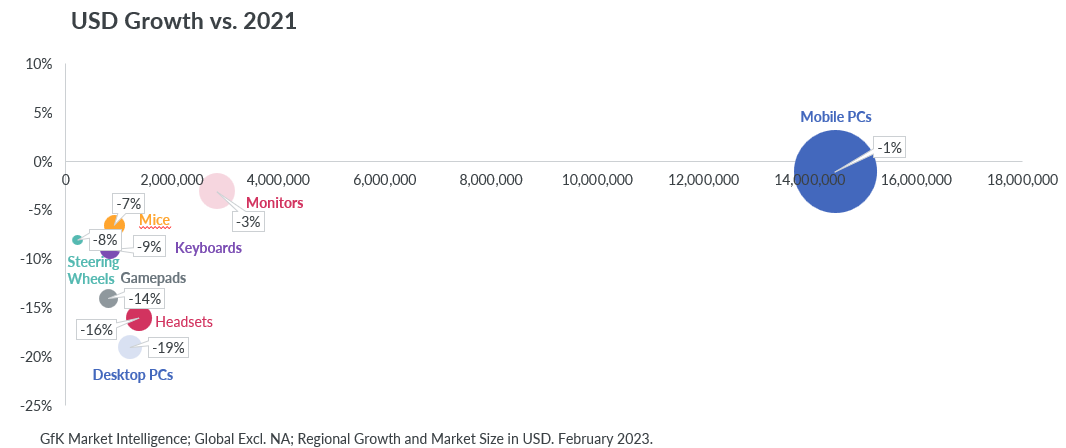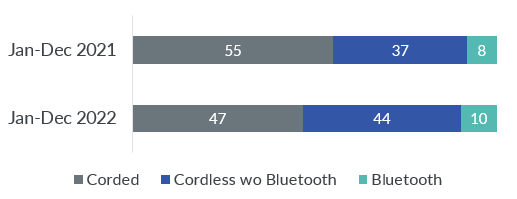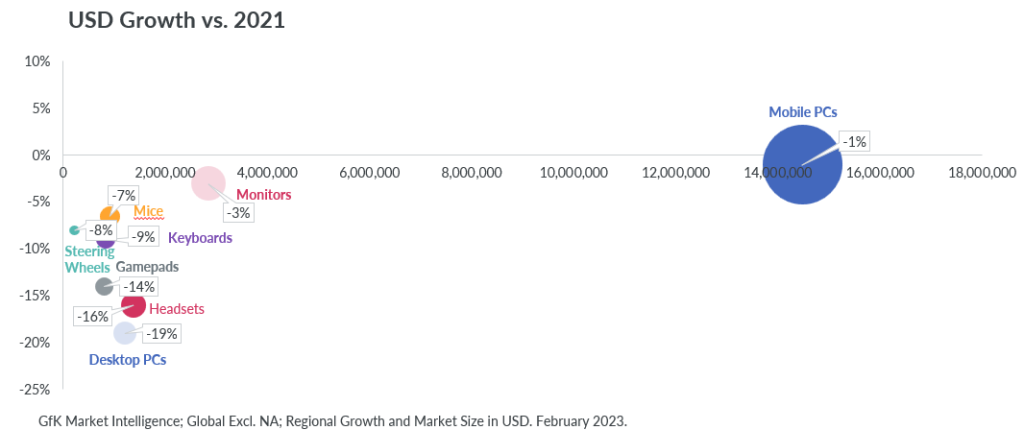The gaming industry is big business. Highly anticipated ‘AAA’ game releases often bring in sales revenue that rivals or even surpasses blockbuster films – on top of additional revenue streams offered by DLC, in-game purchasing, online play and merchandising.
There is also a huge ecosystem of product categories related to console and PC gaming. From the latest monitors, keyboards and gaming mice to headsets and specialized PCs, gamers have a huge amount of choice when it comes to gaming accessories.
Gaming is more popular than ever in every corner of the globe. So why did the games accessory market see a significant decline in 2022 – and what does the data suggest 2023 has in store?
2022: not a great year for gaming accessories
Like a lot of categories related to home entertainment in 2020/21, most gaming categories saw a growth in sales as people reacted to the prospect of prolonged social distancing with upgrading their setups. However, the picture was not entirely positive – as the supply chain disruption began to bite. While most of the headlines concentrated on supply issues relating to the newly launched PS5, a widespread lack of components and raw materials widely impacted the industry.
Disruptions relating to Covid-19 and continued supply chain challenges continued into 2022, where they combined with low consumer confidence, inflation and market volatility. Along with a huge part of the global economy, gaming accessory categories saw a decline in 2022 as many consumers decided to hold off on certain purchases. The only exceptions to the trend were mobile PCs and SSDs.

While decreasing sales has been the overall trend, there are areas of growth too. Premium products that can help with a specific customer need have bucked the trend.
Continued interest in premium products
2023 began with a high degree of uncertainty for manufacturers and retailers. In the TCG and IT market generally, we are seeing a number of trends influence purchasing decisions. With many consumers reducing the number of purchases they make, they are looking to make the ones they do make count. Often, this means premium products that offer higher performance, additional functionality, or durability.
We can see these two trends playing out in gaming accessory categories.
Gaming mice
Consumers are showing a growing preference for cordless and Bluetooth mouse designs. This is primarily because this means fewer wires and easier transportability. Gamers also used to fear time lags when playing and as this has become less of an issue, wireless and Bluetooth gaming devices have become more popular. But we are also seeing the emergence of several new premium features and designs, that could drive increased revenue over the coming years, as for example optical switches. As the prices of cordless and Bluetooth models continue to fall, we are likely to see their share of the market continue to increase.

Keyboards
The same trends can be seen in the gaming keyboard category, where smaller and cordless models continued to grow their share throughout 2022. The big trends that are likely to see growth in 2023 are ultra slim and fully customizable models. These products allow customers to tailor the layout, shape and types of keys used in the designs they buy. Like gaming mice, the cost of Bluetooth models has reduced significantly since 2020 – as has the price of tenkeyless and 60% size models.

What about the Metaverse?
2023 will also see continued activity and interest related to the Metaverse. Many businesses are positioning themselves to compete in this space, although a large degree of uncertainty still exists as to what the revenue potential of the metaverse is for many sectors.
Gamers are likely to be early adopters of the metaverse and VR as many already play Massive Multiplayer Games such as Fortnite, ROBLOX and Minecraft. As such they will already know how to interact in these spaces, as well as be more willing to purchase the hardware and software needed to access them.
A rapidly evolving sector
The good news is that gaming remains a high growth market. Not only is the number of gamers expected to continue growing over the next few years, but they are also likely to continue purchasing products that help enhance that experience, either through superior performance or a simplified setup. Gaming accessories are not as expensive as other entertainment products, so we could see consumers continue to buy to treat themselves. As a group, gamers also tend to spend more money on their devices – helping to drive margins and revenues.
The gaming accessories market is fast-paced, competitive and always evolving. Staying on top means knowing what your consumers are thinking – which is where gfkconsult comes in.
![]()




